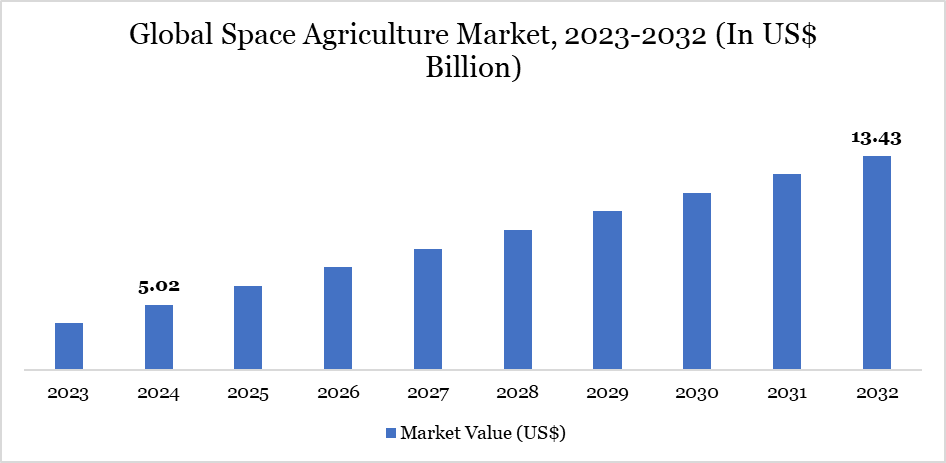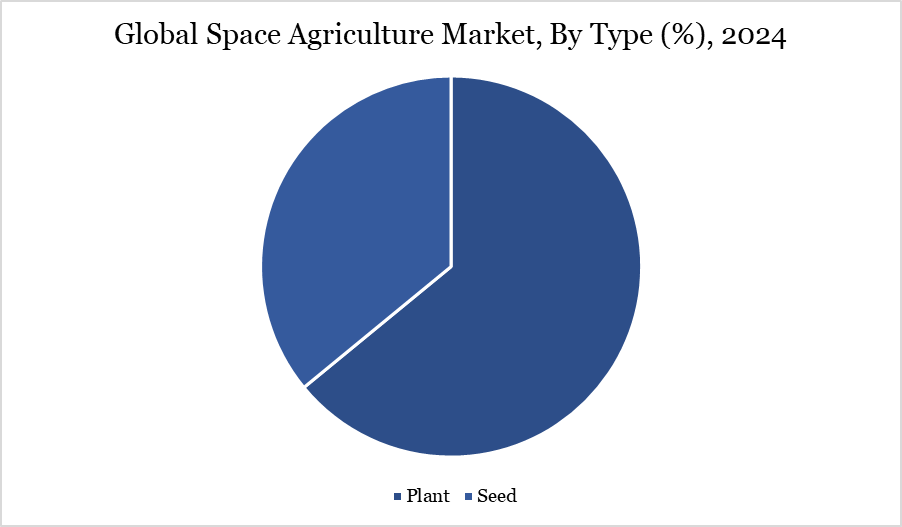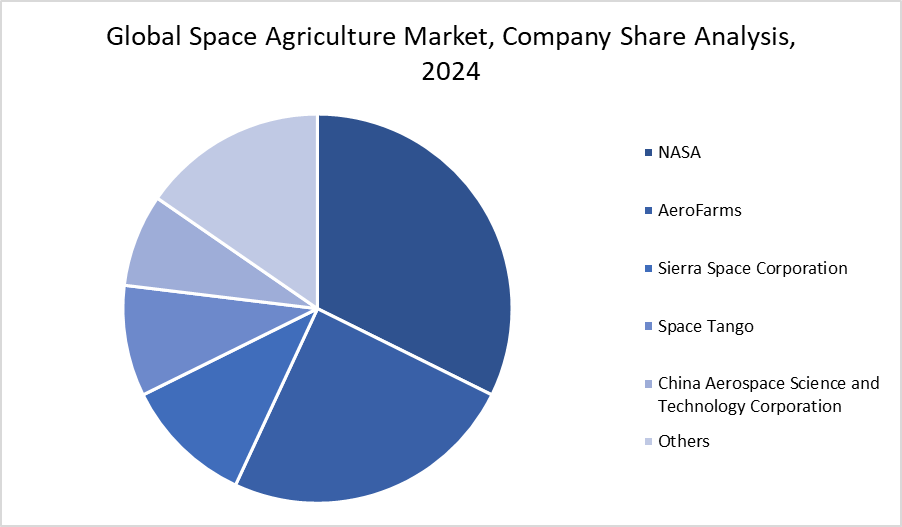Space Agriculture Market Overview
Global Space Agriculture Market reached US$ 5.02 billion in 2024 and is expected to reach US$ 13.4 billion by 2032, growing with a CAGR of 13.09% during the forecast period 2025-2032.
Space agriculture, also known as astroculture, is the growth of plants in outer space to support long-duration human space missions. It offers food, oxygen and resources while also supporting long-term human colonization efforts. Space agriculture employs local resources on celestial bodies, provides fresh food, oxygen generation and psychological advantages and acts as a model for studying astronaut growth behavior in microgravity.

Increased financing and initiatives to advance scientific research are propelling the rise of space agriculture. For example, on June 21, 2023, the US FDA and NASA formed a memorandum of understanding to strengthen collaboration in agriculture research, technology, and management by using science data for decision-making.
Space Agriculture Market Trend
A key trend in the global space agriculture sector is the growing use of advanced biotechnology advances to facilitate long-term food production during protracted space missions. As space agencies and commercial firms strive for long-term human presence beyond Earth, there is a rising emphasis on developing technologies for efficiently producing food in microgravity and other extraterrestrial settings.
It includes breakthroughs in plant growing techniques, cellular agriculture and bioreactors tailored for space environments. The technologies not only aim to assure a consistent food supply for astronauts, but also contribute to the development of sustainable agriculture practices that are used on Earth.
Global Space Agriculture Market Scope
| Metrics | Details |
| By Type | Plant, Seed |
| By Technology | Hydroponics, Aeroponics, Aquaponics, Controlled-Environment Agriculture |
| By Application | Scientific Research, Agriculture, Pharmaceuticals, Others |
| By Region | North America, South America, Europe, Asia-Pacific, Middle East and Africa |
| Report Insights Covered | Competitive Landscape Analysis, Company Profile Analysis, Market Size, Share, Growth |
Global Space Agriculture Market Dynamic
Rising Demand for Sustainable Life Support Systems in Long-Duration Space Missions
A major driver of the global space agriculture market is the increasing need for sustainable life support systems to support long-duration space missions to the Moon, Mars and beyond. With international space agencies like NASA, ESA and Roscosmos, as well as private companies like SpaceX and Blue Origin, advancing plans for deep-space exploration and potential colonization, there is a growing emphasis on self-sufficient food production systems in space.
For example, NASA’s Veggie experiment on the International Space Station (ISS) demonstrated the successful growth of leafy greens in microgravity, showcasing the potential of controlled environment agriculture (CEA) in space. This has accelerated R&D in hydroponics, aeroponics and bioregenerative systems, which are crucial for reducing payload weight and ensuring continuous food supply without dependence on Earth-based resupplies. These innovations are not only pushing forward the space agriculture sector but also inspiring sustainable agri-tech solutions on Earth.
High Costs and Technical Complexity
One major restraint in the global space agriculture market is the high cost and technical complexity associated with developing and maintaining agricultural systems in space environments. Growing food in microgravity or harsh extraterrestrial conditions requires advanced technologies such as controlled environment chambers, artificial lighting, precise nutrient delivery systems and waste recycling mechanisms—all of which demand significant R&D investment.
The establishment of closed-loop life support systems capable of recycling air, water, and nutrients is still in the experimental stage and costs millions of dollars. Furthermore, the logistical hurdles of launching and maintaining equipment in space, as well as assuring crop viability in circumstances of cosmic radiation, limited sunlight, and severe temperatures, make space farming a technically demanding effort. The constraints impede commercialization and wider implementation, particularly for private sector participants.
Request for Free Sample Click Here
Segment Analysis
The global space agriculture market is segmented based on type, technology, application and region.

Advancements in Controlled Environment Agriculture Technologies Drives Plant Segment Growth
A key driver for the plants segment is the rapid progress in Controlled Environment Agriculture (CEA) technologies, which enable optimized plant growth in space-like conditions. Techniques such as LED spectrum-controlled lighting, nutrient film techniques and automated climate regulation are making it increasingly viable to cultivate a variety of crops in space habitats, where sunlight, gravity and natural weather cycles are absent.
For example, Japan’s JAXA has been testing growth chambers on the Kibo module of the ISS, aiming to replicate Earth-like growing conditions to support human life on long-term missions. These innovations reduce dependence on Earth-supplied food, enhance mission autonomy and improve the sustainability of space missions — significantly driving the demand for plant-based systems in space agriculture.
Space Agriculture Market Geographical Penetration
Strong Government and Private Sector Investment in North America
North America space agriculture market is being driven by the significant investment and support from both government agencies and private space enterprises toward space farming technologies. Agencies like NASA are actively funding research programs focused on growing food in space to support long-duration missions to the Moon and Mars under initiatives such as Artemis and the Deep Space Food Challenge.
For instance, NASA’s Veggie experiment aboard the ISS has successfully grown lettuce and other leafy greens in microgravity, paving the way for more complex crop cultivation. Simultaneously, companies like SpaceX and Blue Origin are exploring sustainable life support systems, where space agriculture plays an essential role. This strong ecosystem of public-private collaboration is propelling innovation and growth in the North American space agriculture market.
Sustainability Analysis
The global space agriculture market plays a pivotal role in advancing sustainable life support systems for long-duration space missions and future extraterrestrial colonization. At its core, space agriculture aims to create closed-loop food production systems that minimize reliance on Earth-based resupply missions, significantly reducing carbon footprints associated with frequent rocket launches. These systems are designed to recycle water, air and nutrients, aligning with sustainability principles crucial for both space and terrestrial applications.
Furthermore, technologies developed for growing crops in extreme, resource-limited environments such as hydroponics, aeroponics and vertical farming are increasingly being adapted on Earth, especially in urban areas and regions affected by climate change. For example, plant growth chambers used in space mimic circular economies by utilizing LED lighting, minimal water usage and zero-waste outputs, offering insights for building resilient food systems on Earth.
Competitive Landscape
The major global players in the market include NASA, AeroFarms, Sierra Space Corporation, Space Tango, China Aerospace Science and Technology Corporation, Green Sense Farms, Eden Grow Systems, Orbital Farm, LettUs Grow and Urban Crop Solutions.

Key Developments
- In June 2023, the USDA and NASA signed a memorandum of understanding, strengthening their relationship. This agreement emphasizes collaborative efforts to promote agricultural and Earth science research, technological development, agricultural management methods and the application of scientific data and models to inform agricultural decision-making.
- In January 2023, ESA, DLR and BLE organized an event to bring together the space and agri-food businesses. The goal was to address common issues and provide an agreeable roadmap for future activities.
Why Choose DataM?
- Data-Driven Insights: Dive into detailed analyses with granular insights such as pricing, market shares and value chain evaluations, enriched by interviews with industry leaders and disruptors.
- Post-Purchase Support and Expert Analyst Consultations: As a valued client, gain direct access to our expert analysts for personalized advice and strategic guidance, tailored to your specific needs and challenges.
- White Papers and Case Studies: Benefit quarterly from our in-depth studies related to your purchased titles, tailored to refine your operational and marketing strategies for maximum impact.
- Annual Updates on Purchased Reports: As an existing customer, enjoy the privilege of annual updates to your reports, ensuring you stay abreast of the latest market insights and technological advancements. Terms and conditions apply.
- Specialized Focus on Emerging Markets: DataM differentiates itself by delivering in-depth, specialized insights specifically for emerging markets, rather than offering generalized geographic overviews. This approach equips our clients with a nuanced understanding and actionable intelligence that are essential for navigating and succeeding in high-growth regions.
- Value of DataM Reports: Our reports offer specialized insights tailored to the latest trends and specific business inquiries. This personalized approach provides a deeper, strategic perspective, ensuring you receive the precise information necessary to make informed decisions. These insights complement and go beyond what is typically available in generic databases.
Target Audience 2024
- Manufacturers/ Buyers
- Industry Investors/Investment Bankers
- Research Professionals
- Emerging Companies
Suggestions for Related Report


